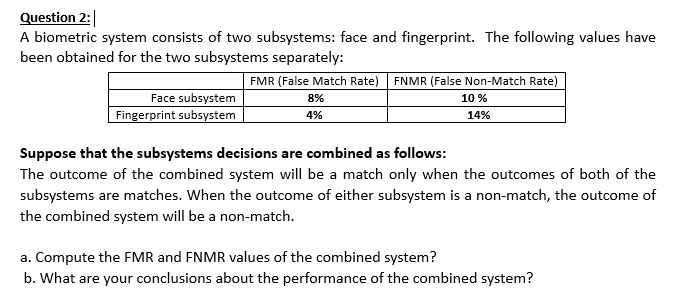Question 2: | A biometric system consists of two subsystems: face and fingerprint. The following values have been obtained for the two subsystems separately: FMR (False Match Rate) FNMR (False Non-Match Rate) Face subsystem Fingerprint subsystem 8% 10 % 4% 14% Suppose that the subsystems decisions are combined as follows: The outcome of the combined system will be a match only when the outcomes of both of the subsystems are matches. When the outcome of either subsystem is a non-match, the outcome of the combined system will be a non-match. a. Compute the FMR and FNMR values of the combined system? b. What are your conclusions about the performance of the combined system?
Question 2: | A biometric system consists of two subsystems: face and fingerprint. The following values have been obtained for the two subsystems separately: FMR (False Match Rate) FNMR (False Non-Match Rate) Face subsystem Fingerprint subsystem 8% 10 % 4% 14% Suppose that the subsystems decisions are combined as follows: The outcome of the combined system will be a match only when the outcomes of both of the subsystems are matches. When the outcome of either subsystem is a non-match, the outcome of the combined system will be a non-match. a. Compute the FMR and FNMR values of the combined system? b. What are your conclusions about the performance of the combined system?
Database System Concepts
7th Edition
ISBN:9780078022159
Author:Abraham Silberschatz Professor, Henry F. Korth, S. Sudarshan
Publisher:Abraham Silberschatz Professor, Henry F. Korth, S. Sudarshan
Chapter1: Introduction
Section: Chapter Questions
Problem 1PE
Related questions
Question

Transcribed Image Text:Question 2:
A biometric system consists of two subsystems: face and fingerprint. The following values have
been obtained for the two subsystems separately:
FMR (False Match Rate) FNMR (False Non-Match Rate)
Face subsystem
| Fingerprint subsystem
8%
10 %
4%
14%
Suppose that the subsystems decisions are combined as follows:
The outcome of the combined system will be a match only when the outcomes of both of the
subsystems are matches. When the outcome of either subsystem is a non-match, the outcome of
the combined system will be a non-match.
a. Compute the FMR and FNMR values of the combined system?
b. What are your conclusions about the performance of the combined system?
Expert Solution
This question has been solved!
Explore an expertly crafted, step-by-step solution for a thorough understanding of key concepts.
This is a popular solution!
Trending now
This is a popular solution!
Step by step
Solved in 2 steps with 3 images

Knowledge Booster
Learn more about
Need a deep-dive on the concept behind this application? Look no further. Learn more about this topic, computer-science and related others by exploring similar questions and additional content below.Recommended textbooks for you

Database System Concepts
Computer Science
ISBN:
9780078022159
Author:
Abraham Silberschatz Professor, Henry F. Korth, S. Sudarshan
Publisher:
McGraw-Hill Education

Starting Out with Python (4th Edition)
Computer Science
ISBN:
9780134444321
Author:
Tony Gaddis
Publisher:
PEARSON

Digital Fundamentals (11th Edition)
Computer Science
ISBN:
9780132737968
Author:
Thomas L. Floyd
Publisher:
PEARSON

Database System Concepts
Computer Science
ISBN:
9780078022159
Author:
Abraham Silberschatz Professor, Henry F. Korth, S. Sudarshan
Publisher:
McGraw-Hill Education

Starting Out with Python (4th Edition)
Computer Science
ISBN:
9780134444321
Author:
Tony Gaddis
Publisher:
PEARSON

Digital Fundamentals (11th Edition)
Computer Science
ISBN:
9780132737968
Author:
Thomas L. Floyd
Publisher:
PEARSON

C How to Program (8th Edition)
Computer Science
ISBN:
9780133976892
Author:
Paul J. Deitel, Harvey Deitel
Publisher:
PEARSON

Database Systems: Design, Implementation, & Manag…
Computer Science
ISBN:
9781337627900
Author:
Carlos Coronel, Steven Morris
Publisher:
Cengage Learning

Programmable Logic Controllers
Computer Science
ISBN:
9780073373843
Author:
Frank D. Petruzella
Publisher:
McGraw-Hill Education